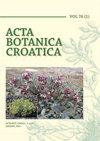The anatomy, micromorphology, and essential oils of the Turkish endemic and endangered species Alchemilla orduensis
IF 1.1
4区 生物学
Q3 PLANT SCIENCES
引用次数: 0
Abstract
In this study, the anatomical and micromorphological characteristics of the vegetative organs and the essential oil constituents of the aerial and underground parts of the local and endangered endemic species A. orduensis Pawł. were evaluated. For anatomical study, sections of root, rhizome, stem, leaves and petiole were excised and stained with safranin/fast green mixture. Leaf and petiole structures were examined micromorphologically. Essential oil contents were determined by headspace solid-phase microextraction coupled with gas chromatography-mass spectrometry (HS-SPME/GC-MS) analysis. The results showed that rectangular meristematic cells were present in the root. The leaf is of the bifacial and amphistomatic type. Stomata cells are of the anomocytic type. The stomatal index for the upper surface of the leaves is 0.04, while the stomatal index for the lower surface is 0.17. Druse crystals were found in the rhizome, stem and leaves. Among the various compounds identified, the most abundant groups in the aboveground parts are alcohols (39.81%) and ketones (14.99%) with 1-Octen-3-ol, 1-octan-3-one and borane- methyl sulfide complex as the main compounds. Terpenes (23.44%) and alcohols (11.82%), in which myrtenolis was the main compound, were most abundant in the underground parts.土耳其特有的濒危物种 Alchemillaorduensis 的解剖学、微形态学和精油
本研究评估了当地濒临灭绝的特有物种 A. orduensis Pawł. 植物器官的解剖学和微观形态特征,以及气生和地下部分的精油成分。在解剖学研究中,切除根、根茎、茎、叶和叶柄的切片,并用黄红素/快绿素混合物染色。对叶片和叶柄结构进行微观检查。精油含量采用顶空固相微萃取-气相色谱-质谱联用(HS-SPME/GC-MS)分析法进行测定。结果表明,根部存在矩形分生细胞。叶片为双面和两面型。气孔细胞属于异形细胞类型。叶片上表面的气孔指数为 0.04,而下表面的气孔指数为 0.17。在根茎、茎和叶中发现了琉璃晶体。在已鉴定的各种化合物中,地上部分含量最多的是醇类(39.81%)和酮类(14.99%),其中 1-辛烯-3-醇、1-辛烷-3-酮和硼烷-甲基硫化物复合物是主要化合物。萜烯类(23.44%)和醇类(11.82%)在地下部分含量最高,其中的主要化合物是桃金娘。
本文章由计算机程序翻译,如有差异,请以英文原文为准。
求助全文
约1分钟内获得全文
求助全文
来源期刊

Acta Botanica Croatica
PLANT SCIENCES-
CiteScore
2.50
自引率
0.00%
发文量
34
审稿时长
>12 weeks
期刊介绍:
The interest of the journal is field (terrestrial and aquatic) and experimental botany (including microorganisms, plant viruses, bacteria, unicellular algae), from subcellular level to ecosystems. The attention of the Journal is aimed to the research of karstic areas of the southern Europe, karstic waters and the Adriatic Sea (Mediterranean).
 求助内容:
求助内容: 应助结果提醒方式:
应助结果提醒方式:


